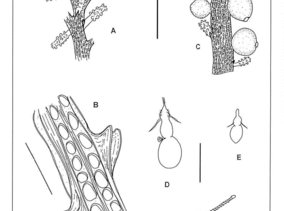You are here
Taxon
Solanderia secunda (Inaba, 1892)
Nomenclature
-
Family: SolanderiidaeGenus: Solanderia
-
Synonyms: 6
SUMMARY
Hydrorhiza a cluster of stolons strongly entwined around substrate.
Colonies arborescently branched in one plane, several main branches arising from a thick, short trunk; trunk of largest colony 4 mm thick near base; in older colonies many orders of branching, the branches thinning to growing tips. Skeletal meshwork on younger branches penetrated by lines of oval to quadrangular perforations aligned parallel to axis of branch, this pattern often obscured in older branches and stem.
Mean of 50 hydranths per cm along length of branch; in life, hydranths large, cylindrical, supported on prominent bicuspid skeletal spines; all tentacles capitate, four oral and 15-20 others scattered over body.
Gonophores male, eumedusoid, large, globular, with four radial canals (not visible in preserved material) and a small raised apical cap; peduncle very short; no nematocysts.
Cnidome: Nematocysts in capitala of tentacles:
i) Large stenoteles, capsule subspherical, 17-17.5 x 13-14 µm, shaft 25 µm long with several long spines, tubule thick; moderately abundant.
ii) Smaller stenoteles, capsule ovoid, 8.5- 9 x 6.5-7 µm shaft (partially discharged) about same length as capsule; tubule not seen; abundant.
iii) ?Isorhizas, capsule subspherical, I 0 x 9 µm, tubule 25 µm (partially discharged) finely spinous; rare in some hydranths, absent from others.
Colour: Colonies black in situ, under stereo-microscope deep purple, fading to mauve on tips of branches –or- brown, fading to yellowish on tips of branches. Hydranths white, gonophores scarlet (leaching to white in alcohol), radial canals white.

